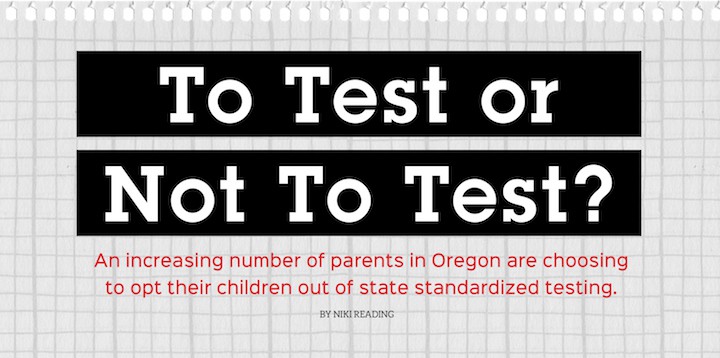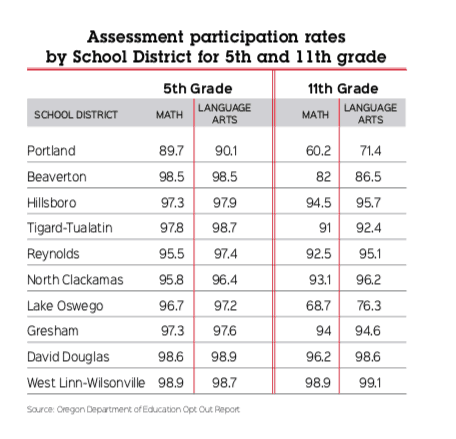
An increasing number of parents in Oregon are choosing to opt their children out of state standardized testing.
April LaCombe’s daughter, Leah, was a great student who excelled at math. The problem: She wasn’t so great at standardized testing.
So when it came time for the Southeast Portlander to take a readiness test in sixth grade to determine whether she would proceed to accelerated math or continue at the standard pace, it was disastrous, LaCombe says. Her daughter scored very low, and the principal wouldn’t reconsider her daughter’s math placement.
Leah is now 16 years old and a junior at Cleveland High School. She took double math classes last year so she can take calculus before graduation. LaCombe, meanwhile, has opted both of her daughters out of standardized testing since then.
The twist: LaCombe is a Portland Public Schools teacher with nearly three decades of experience. Her own students are tested annually. Her observations in the classroom combined with her daughter’s experience has underscored what she already knew in her gut: “There’s a decade of research that proves these tests don’t give the student meaningful information on their academic progress,” she says.
The push — and pushback — for more testing
In 2001, President George W. Bush signed the No Child Left Behind act into law. The law required standardized testing in reading and math in grades 3 to 8, as well as once in high school. The tests would also be used to measure a school’s relative success, rather than just an individual student’s progress. It has since been replaced by ESSA, or the Every Student Succeeds Act, which was signed into law by President Obama in 2015, which still requires standardized testing as part of the evaluation of schools.
By making that pivot — from using testing to evaluate individual students to using it to evaluate schools and districts — tests became much more high stakes, says state Sen. Lew Frederick, a Democrat who represents North and Northeast Portland in the state Legislature. Frederick, a former communications director for Portland Public Schools, says that pivot was a mistake, because it added significant pressure to a single measurement.
“I have been very concerned about the testing because it doesn’t appear to be effective, it appears to cost an awful lot of money, it appears to be a distraction, and it encourages a system where you don’t have a lot of confidence in the education system,” Frederick says. As a result, Frederick, who is also a former teacher, pioneered the Student Assessment Bill of Rights, a statewide law that allows parents to opt their children out of statewide assessments more easily — and does not require parents to provide a reason for opting out.

In 2015-2016, the first year the law was in effect, about 8.3 percent of parents opted their children out of English language arts/literacy, and 8.9 percent opted out of math. Two years later, more than 1 in 10 students statewide opted out of the Smarter Balanced test, which is the standardized test in English and math that Oregon helped develop for grades 3-12, currently in use in many other states.
Locally preliminary data shows that more than 3,000 Portland Public Schools students — or 11.3 percent — opted out of English language arts/literacy, whereas 11.6 percent opted out of math.
Opt out and dropping test scores
It’s not just the percent of students taking the test that’s dropping: Overall test scores are also dipping. In 2017-2018, about 60 percent of students failed to meet math requirements and 45 percent failed to meet requirements in reading and writing across the state. Those results have stayed consistently low for each of the four years Oregon has used the Smarter Balanced test.
Joe Suggs, PPS System Planning and Performance Manager, says those two figures may be related: As more parents opt out of “summative” testing — a test given after a lesson unit is complete — more students see the test as less important, and therefore don’t put as much effort into it.
“Testing has a role in informing how we’re doing as a district and a school. To not have a student take the test affects that,” he says. Administrators with Portland public schools say they have not analyzed the opt-out data to determine whether certain demographics are more likely to opt out. But if higher-income families are more likely to opt out, for example, it could skew the validity of the tests because of persistent achievement gaps among children from low- and high-income families.
Suggs says he knows many parents and teachers think too much time is spent testing, and that the tests are too high stakes, but he still says the tests are critical.
“If you look at a truly proper instructional model, assessment has to be embedded in the learning and informing it,” he says, and that can’t happen if large swaths of students opt out of testing altogether.
Deciding what’s right
Pat McCreary is another parent who comes to the testing issue with an educator’s perspective. As a high school social studies teacher in Beaverton, he’s had many parents ask his thoughts on the issue. “Standardized testing is one of those things that, at some point, people heard it wasn’t good. So when parents say they don’t like it, I like to push back a little and ask why,” he says.
When it came to his own kids, a junior and freshmen at Cleveland High School, he and his family weighed the pros and cons, taking each child’s needs into account. His criticisms of standardized tests are that they measure achievement rather than learning, they can take up a lot of time, and “you often have people who are writing the test who may not be representative of the students taking the test,” which can create cultural bias and skew results.
On the other hand, he says, the tests are rooted in good intentions: “Philosophically, the idea is to ensure that all students are being given equitable access to a quality education,” he says.
After discussing the issue, he and his wife asked his kids what they wanted. “They both opted to do it and they did fine,” he says.
LaCombe says her daughters participate in shorter tests throughout the year, like Dibels (Dynamic Indicators of Basic Early Literacy Skills, a test administered to lower grades) to determine early literacy skills, because those tests quickly determine areas for improvement and allow teachers to help their students fill in skills gaps. But she’s a vocal opponent of the year-end standardized tests like Smarter Balanced.
“When you think about an assessment, what is the purpose? If the purpose is to inform instruction in the classroom, that’s great. If you need it for anything more than that, then forget about it,” she says.
Suggs, on the other hand, says the data from these tests helps schools and districts assess the quality of programming and can’t be eliminated. He says if you’re not sure what to do, ask. “Talk to the teacher, go to the principal or someone in central administration so you can discuss how the results are used, what the context is, and whether it’s the right option,” he says.
How to Opt Out
The Student Assessment Bill of Rights, passed in 2015, made it easier for families to opt out of statewide tests. Parents and guardians can now opt out by signing a form with their child’s basic information — name, age and school — as well as the parent or guardian’s signature. The form does not ask for a reason for opting out of the test.
Forms are available at the Oregon Department of
Education site here: oregon.gov/ode/educator resources/assessment
- Summer Camps with Space - April 16, 2024
- Portland Half-Day Summer Camps - April 16, 2024
- Summer Camps with Space - April 15, 2024






